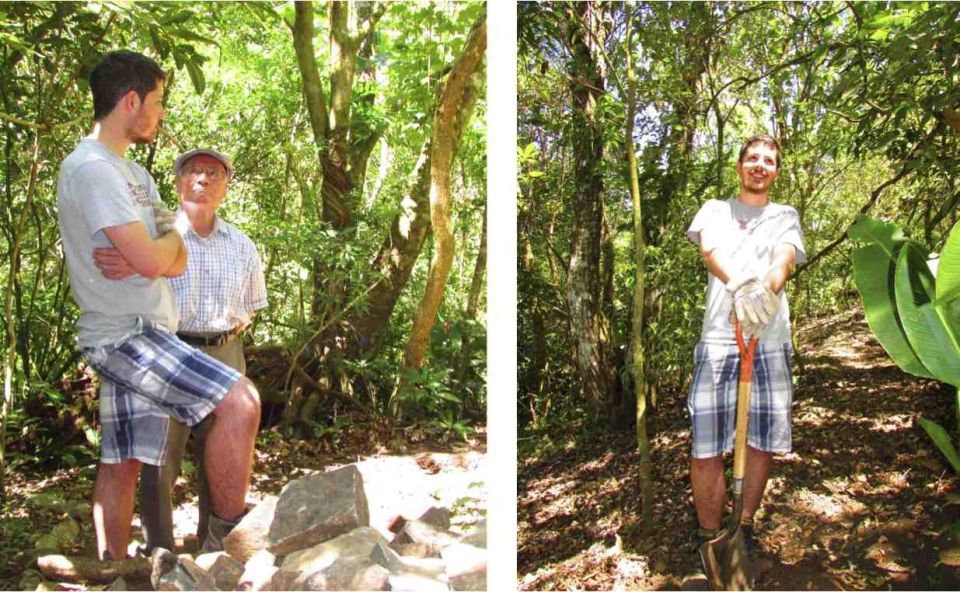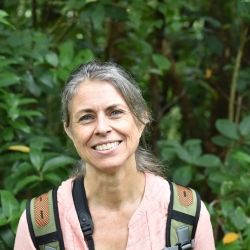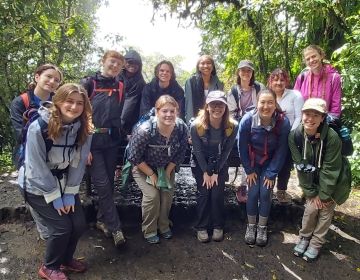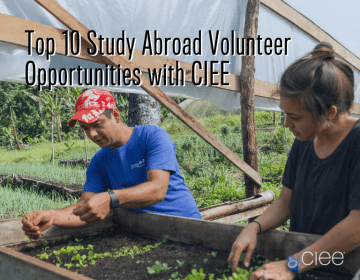CIEE INTERNSHIPS AT THE BAJO DEL TIGRE RESERVE OF THE CHILDREN’S ETERNAL RAINFOREST
Three students interned for the benefit of the Monteverde Conservation League and ProNativas this Spring 2015 semester. Hannah Irvine (Earlham College), Matthew Brodeur (University of Massachusetts Amherst), and Rachel Cook (University of Colorado-Boulder), each dedicated efforts in the Bajo del Tigre Nature Reserve, a reserve in the heart of Monteverde and part of the Children’s Eternal Rainforest. Although their projects were highly diverse, they are united in a couple of important ways. They are all centered in ProNativa's Demonstration Garden, where people can experience, firsthand, native plants and wildlife of a tropical forest. Also, the projects seek to attract visitors and enhance the overall experience in eco-friendly and sustainable ways. The interns were guided by Bob Law, Felipe Negrini, and Willow Zuchowski. Here, the interns describe their accomplishments!
From left, Matt and Bob in front of ongoing birdbath construction; Rachel in the process of painting; Hannah and Felipe in front of finished sign Hannah carves sign (left) and an example of a carved, painted, and mounted sign (right).Hannah Irvine (Earlham College) says, "In my study abroad program in Monteverde, Costa Rica, I worked at an internship in a nature reserve called Bajo del Tigre. Bajo Del Tigre is a part of the Children's Eternal Rainforest which is the largest private nature reserve in Costa Rica at 22,500 ha. My internship was focused in a small garden on the edge of Bajo Del Tigre, known as the Demonstration Garden. The purpose of this garden is to highlight many of the plant species that are native or endemic to Monteverde. ProNativas, a small organization that encourages the use native plants, created this garden in conjunction with Bajo Del Tigre and the Monteverde Conservation League, the organization that administers Children's Eternal Rainforest and strives to preserve biodiversity in Monteverde.
My sustainability challenge in this garden was to create some type of interpretation material for the plants along the trail. Before I started working, many visitors did not know that there were trails in the section of forest and also did not know about the native plants inside the garden. I decided to create signs that explained a couple of the most common plant species in the garden. With the help and guidance of Willow Zuchowski, the founder of ProNativas, I chose between 10 and 20 plants to focus on. I worked with my internship advisor, Felipe Negrini, to develop an organic-looking sign that could be placed in the garden. I used a wood-carving tool called a router to carve out the scientific and common names as well as a sentence or two of information into a piece of wood. The wood is Tubú, a common native plant often used as a windbreak. Next, I painted over the letters, put on a protective varnish, and mounted them onto posts. The signs are placed all over the garden and are designed not only to pull visitors into the garden, but to inform them about native plants in Monteverde."
Matthew Brodeur (University of Massachusetts Amherst): "One of the most distinguishing features of Monteverde is its incredible biodiversity. Because of this, it is crucial that the region’s human residents ensure that wildlife can thrive despite a widespread human footprint. My internship takes place at Bajo del Tigre, a nature reserve in Monteverde, where my primary goal is to help birds and other animals handle the Costa Rican dry season. With this goal in mind, I have designed and created a birdbath which will ensure that these special species can survive the annual drought which is expected to increase in severity due to climate change.
While the primary goal of this internship is undoubtedly to create a functional birdbath to assist wildlife, there are many other considerations to keep in mind. For example, how can the birdbath be constructed in a sustainable manner that minimizes the impact on the environment? Furthermore, how can the birdbath blend into the environment so that it doesn’t feel out of place? To accomplish both of these criteria, we decided that locally extracted rock would be the most sustainable, natural material. It doesn’t require processing, it’s found in abundance in natural settings, and it does not have an unnatural, rigid form. Hopefully, taking into account all of these factors will make sure that the birdbath is an exciting feature of Bajo del Tigre (for birds and people) for years to come!"

Rachel Cook (University of Colorado-Boulder)
Rachel begins the creation of the mural, to draw visitors to the native plant garden at Bajo del TigreFor the past 4 weeks I have been working at Bajo del Tigre, an educational attraction owned by the Monteverde Conservation League. During my time working there I was able to accomplish a mural that helped to provide “ an interpretation” for their demonstration garden. I chose to approach the mural by demonstrating the many important animal-plant relationships that the garden hosts. By doing so I was staying with the overall goal of the Demonstration Garden at Bajo del Tigre, which is to show visitors the importance of planting native plants in their gardens. Completing the mural in an accurate and informative manner was by far the most challenging aspect of the processes. To do so however, I divided my time into two parts: I spent the first two weeks researching and the last two weeks actually painting the mural, and by the end I believe I was able to accomplish my goal.
To begin the research component of my mural, I needed to walk around the demonstration garden with a very experienced botanist, Willow Zuchowski and decide on the plants that would be good options to include. I then had to research the relationships with animals these plants had in order to create an accurate food web. This included using Willow and my internship supervisor as well as online and textbook resources to be as thorough as possible. After much revision and approval from Willow, the food web was completed. The next step was to get approval to paint the mural where I wanted to (the outdoor wall of the classroom at Bajo del Tigre). Once approval was granted I was able to begin a sketch of the mural layout using information from my food web. Simultaneously I made notes about the unique characteristics of individual plants and animals I needed to include for accuracy. Finally, with 2 weeks left, I was able to begin painting the actual mural. In the end, I was able to include 16 relationships in a format I believe is scientifically accurate.
Rachel in front of the work of art!Related Posts
Costa Rica vs. Argentina: Which is Better for Study Abroad?
Imagine yourself sipping mate in a bustling Buenos Aires café or lounging peacefully in a hammock overlooking Costa Rica's lush rainforests. These contrasting scenes represent just a glimpse of the... keep reading
Happy Earth Day: Today and Every Day
Happy Earth Day! Every April 22, this global event comes around to remind us how precious our planet is, what sustainable efforts we can make to protect Earth, and that... keep reading
Top 10 Study Abroad Volunteer Opportunities with CIEE
Have you ever wondered if you could volunteer abroad? Perhaps you're looking into study abroad programs that provide international volunteer opportunities. If you’re itching to study abroad and truly make... keep reading



